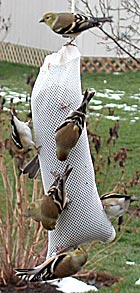Blog - General
About Goldfinch
We receive numerous questions from customers about the goldfinch, one of the most desirable birds attracted to backyard bird feeders. Often times people wonder if they migrate south for the winter, or they are concerned about the lack of goldfinch at the bird feeders in late summer through early fall. Goldfinch, as with many birds, follow an annual cycle.
wonder if they migrate south for the winter, or they are concerned about the lack of goldfinch at the bird feeders in late summer through early fall. Goldfinch, as with many birds, follow an annual cycle.
Lets begin in the fall at a time when many plants, such as tall thistle and coneflowers, have gone to seed. As with most birds that eat seeds and fruits, the autumn ripening of natural foods is hard to ignore. These food resources are short lived and birds will take advantage of their availability. That will slow down the visit of birds to the bird feeders, especially in rural areas where natural foods are more abundant. Our summer resident goldfinch are attracted to these natural offerings, but they also begin to drift to the south by October. At the same time the Arctic cold fronts from Canada begin to escort goldfinch from the north into the Central Great Plains and Midwest. This northern population of goldfinch are those that will delight us at the bird feeders during the winter months.
By the second week of March, as winter begins to release it’s grip on the Central Great Plains, our resident goldfinch begin to move back into the area from southern states where they wintered over. They join up with the northern population of goldfinch that remain with us until mid-spring as it is still pretty wintry to the north during March and April. This is when it can become a daily task to keep the thistle feeders filled. Its not unusual for some people to have 40 to 50 goldfinch or more at this time. It is also the time when the males will begin to dawn their bright canary yellow mating plumage.
As the dandelions begin to bloom, generally by the first week in May, the northern population of goldfinch will start to follow that bloom north, slowly returning to their nesting territory. The numbers of goldfinch at our feeders is significantly reduced as they depart. Our resident goldfinch will remain at the thistle feeders until late June at which time they will drift out into the country where they nest in plum thickets, small trees, and other shrubs. Since goldfinch feed their nestlings strictly seed, they wait until mid-summer to nest when such food is abundant. Those who live in rural areas will have goldfinch visit their feeders throughout the summer months. But in urban areas their numbers will have been reduced to a few un-mated pairs. The molt will begin in September, and by October the cycle will start over once again.
Wingtip: Fresh Nyjer thistle seed is key to attracting goldfinch, Pine Siskin, and other finch. Many outlets, such as grocery, big box, and discount stores, warehouse thistle seed for extended periods of time and it becomes stale and undesirable to these birds. Purchase your thistle seed from reputable dealers. At Wild Bird Habitat our Nyjer thistle is delivered fresh on a weekly basis.
